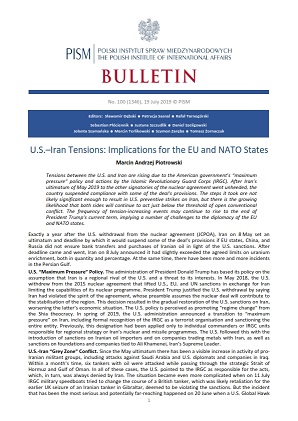U.S.–Iran Tensions: Implications for the EU and NATO States
U.S.–Iran Tensions: Implications for the EU and NATO States
Author(s): Marcin Andrzej Piotrowski
Subject(s): Governance, International relations/trade, Geopolitics, Peace and Conflict Studies
Published by: PISM Polski Instytut Spraw Międzynarodowych
Keywords: United States; Iran; European Union; NATO; US-Iranian relations; tensions; nuclear agreement; conflict;
Summary/Abstract: Tensions between the U.S. and Iran are rising due to the American government’s “maximum pressure” policy and actions by the Islamic Revolutionary Guard Corps (IRGC). After Iran’s ultimatum of May 2019 to the other signatories of the nuclear agreement went unheeded, the country suspended compliance with some of the deal’s provisions. The steps it took are not likely significant enough to result in U.S. preventive strikes on Iran, but there is the growing likelihood that both sides will continue to act just below the threshold of open conventional conflict. The frequency of tension-increasing events may continue to rise to the end of President Trump’s current term, implying a number of challenges to the diplomacy of the EU and NATO states.
Series: PISM Bulletin
- Page Count: 2
- Publication Year: 2019
- Language: English
- Content File-PDF

